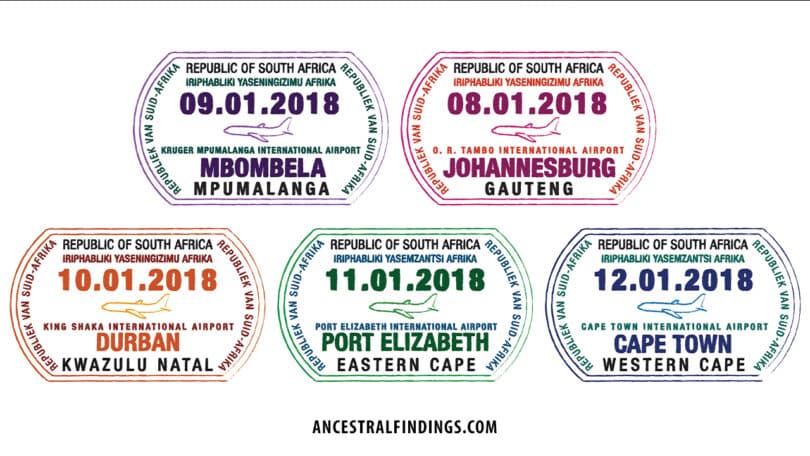South Africa’s history is a fascinating migration, with people arriving from all over the world and others leaving to build new lives in different lands. Understanding the patterns of immigration and emigration can open up new doors in your genealogical research, revealing the journeys your ancestors took, why they moved, and where they settled. Let’s explore the various waves of migration into and out of South Africa and how you can trace these movements in your family history.
A Brief History of Immigration to South Africa
South Africa’s population has been shaped by multiple waves of immigration, each leaving its mark on its cultural and social landscape. Knowing when and why certain groups arrived can help you focus your genealogical research on specific records and archives.
Early European Settlers (1600s-1800s)
The first significant wave of European immigration began in the 1600s with the establishment of the Cape Colony by the Dutch East India Company. Dutch settlers, often called Boers or Afrikaners, were soon followed by French Huguenots fleeing religious persecution and German and Scandinavian settlers. These groups primarily settled in what is now known as the Western Cape.
Key Records to Look For:
Early immigration registers, ship passenger lists, and church records, particularly those kept by the Dutch Reformed Church (NGK) and French Huguenot churches. The National Archives of South Africa (NASA) holds many of these records.
British Colonization (1800s-1900s)
The British took control of the Cape Colony in the early 1800s, and by 1820, thousands of British settlers were encouraged to emigrate to South Africa as part of the 1820 Settlers Scheme. This wave of immigration profoundly shaped the Eastern Cape and set the stage for future Anglo-Boer conflicts.
Key Records to Look For:
Records from the 1820 Settlers Scheme, British ship manifests, and letters of correspondence between families in Britain and their relatives in South Africa. The Eastern Cape Archives is a vital source for records from this period.
Indian Labor Migration (1860s onwards)
During British rule, Indian laborers were brought to South Africa to work on the sugar plantations of Natal. Many of these workers stayed and built communities in Durban and surrounding areas. Today, South Africa has a large population of Indian descent, particularly in KwaZulu-Natal.
Key Records to Look For:
Indian indenture records, ship manifests from Calcutta and Madras, and colonial records documenting their labor contracts. The Gandhi-Luthuli Documentation Centre at the University of KwaZulu-Natal holds significant resources on Indian migration.
Jewish and Other European Immigrants (Late 1800s-Early 1900s)
Many Jewish immigrants, fleeing persecution in Eastern Europe, arrived in South Africa during the late 19th and early 20th centuries. These immigrants primarily settled in cities like Johannesburg and Cape Town, contributing significantly to South Africa’s cultural and business landscape.
Key Records to Look For:
Immigration documents from Lithuania, Russia, and Poland and Jewish community records are often housed in local Jewish archives, such as the South African Jewish Museum and its online genealogical resources.
Emigration from South Africa
While South Africa has historically been a destination for immigrants, it has also seen periods of significant emigration, especially during political upheavals like apartheid and economic crises.
Emigration During the Apartheid Era (1948-1994)
Many South Africans, particularly those who opposed apartheid, left the country between the 1960s and 1990s. These emigrants settled in countries like the United Kingdom, Canada, Australia, and the United States, seeking freedom and better opportunities.
Key Records to Look For:
Immigration documents in destination countries, as well as South African passport records. Some archives in countries like the UK and Australia have records specific to South African immigrants. Online databases like Ancestry.com may also have these emigration records.
Modern Emigration (Post-1994)
Following the end of apartheid, economic uncertainty led to a new wave of emigration. Skilled professionals, in particular, left for Europe, North America, and the Pacific region in search of better job prospects. These emigrants often maintained ties with South Africa, returning for visits or family events.
Key Records to Look For:
Modern travel records, visa and residency applications, and dual citizenship documents. You can also trace family connections through social media or professional networks like LinkedIn.
How to Research Immigration and Emigration Records
Tracking your ancestors’ movements in and out of South Africa requires digging into multiple types of records. Here’s how to get started:
Passenger Lists and Ship Manifests
Ship passenger lists are some of the most direct records for tracing immigration. Many European immigrants, as well as Indian laborers, arrived by sea, and the ship manifests often recorded names, ages, occupations, and places of origin. You can find these records in the National Archives of South Africa and through online databases like FindMyPast and Ancestry.com.
Immigration and Naturalization Records
Once immigrants arrived in South Africa, they often applied for citizenship or residency, particularly during British and Dutch rule. Naturalization records can offer valuable clues about an ancestor’s journey, including their country of origin, family members, and sometimes even their reasons for emigrating.
Where to Look:
The National Archives, Provincial Archives, and the South African Department of Home Affairs are key sources for these records.
Estate and Wills Records
Estate and will records can provide insight into family connections for those who emigrated and left property behind. These documents often name family members, offering a chance to trace an individual’s family even after they’ve left the country.
Where to Look:
Estate records can be found in the National Archives of South Africa and through local Deeds Offices.
Church and Cemetery Records
Church records, particularly those from the Dutch Reformed Church and Anglican Church, often record immigrants’ baptisms, marriages, and deaths. Similarly, cemetery records can provide information on ancestors who passed away after arriving in South Africa or those who left but were buried back in their homeland.
Where to Look:
Check local church archives, FamilySearch, or cemetery databases like Find A Grave for information on your ancestors.
Overcoming Challenges in Immigration Research
Researching South African immigration and emigration can be tricky due to gaps in records, language barriers, and changing political landscapes. Here are some tips to overcome these challenges:
Language Barriers: South African records are often in Dutch, Afrikaans, or English. To interpret documents, use online translation tools or collaborate with native speakers.
Missing Records: Political turmoil, such as during the Anglo-Boer War and apartheid, caused many records to be lost or destroyed. When official records aren’t available, try turning to oral histories or family letters that may have been passed down through generations.
Collaborate Globally: Many South African immigrants moved to countries with well-documented immigration records, such as Australia, Canada, or the UK. Reaching out to genealogists or archives in those countries may help fill in gaps left by South African records.
South Africa’s story is one of movement—of people coming to and leaving the country in search of new opportunities, freedom, or simply a better life. By understanding the various immigration and emigration patterns, you can unravel your family’s unique history. With the right resources, you can trace your ancestors’ journeys across oceans and continents, bringing their stories back to life.







